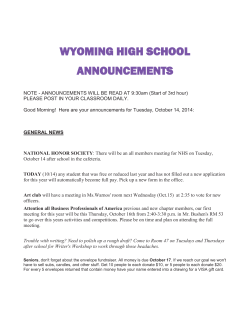
WOMEN AND NEWBORN HEALTH SERVICE 2 PATIENT ADMINISTRATION 2.1
WOMEN AND NEWBORN HEALTH SERVICE King Edward Memorial Hospital CLINICAL GUIDELINES SECTION A: GUIDELINES RELEVANT TO OBSTETRICS AND GYNAECOLOGY 2 PATIENT ADMINISTRATION 2.1 PATIENT IDENTIFICATION DPMS Ref: 3441 All guidelines should be read in conjunction with the Disclaimer at the beginning of this manual Page 1 of 3 AIM The correct identification of patients at KEMH in order to comply with Operational Directive OD 0486/14 KEY POINTS 1. All inpatients, including Family Birth Centre, MFAU, Emergency Department patients and Day Surgery/procedure patients must be correctly identified at the time of admission and throughout their hospital stay. 2. All patients shall be positively identified prior to patient registration / admission by: • Asking the patient (if conscious and able) to spell their family name and given name, and state their date of birth and address. • Where the patient is unable to give this information, all reasonable attempts must be made to confirm the patient’s identity which can include an accompanying adult, checking with other identification (e.g. driver’s licence) or via an interpreter. This should be documented in the health care record. • Where possible the patient must view and verify that the details on the identification band are correct. If the patient is unable to do so, the next of kin / legal guardian/ carer may undertake this responsibility; otherwise a second staff member must check the information on the identification band against the admission details. • 3. All inpatients, day procedure patients and Emergency Department patients (if practical) shall have an identification band securely attached immediately after the patient’s registration/ admission and the details checked with the patient before any treatment, collection of pathology samples, blood transfusion, drug administration or X-rays are undertaken. 4. A single white identification band should be used for adult patient identification. 5. The identification band must have only the core identifiers: family name and given name (Family name in UPPER case letters followed by given name in Title case), UMRN, and DOB. If possible, the patient must view and verify that these details are correct. If the patient is unable to do so, the next of kin/legal guardian/carer may undertake this responsibility; otherwise, a second staff member must check the information on the identification band against the admission details. 6. Where possible, the identification band shall remain on the patient throughout the hospital admission. 7. If an identification band inadvertently comes off, or is removed for treatment and not replaced immediately, it cannot be reattached. In this case, the patient must be re-identified and a new identification band attached. DPMS Ref: 3441 • Checking that the identification band is securely attached to the patient. • Asking the patient (if conscious and able) to spell their family name and given name, All guidelines should be read in conjunction with the Disclaimer at the beginning of this manual Page 2 of 3 and state their date of birth and address. Where necessary, the next of kin/legal guardian/carer may undertake this responsibility. 8. Verification of the patient’s identification should be documented in the patient’s health care record. 9. Patients with a known allergy should be issued with a RED patient identification band. The use of a red identification band signifies a patient with a known allergy including, but not limited to, 2 drugs, food, lotions and substances (e.g. latex). 10. Only one colour identification band should be used at any one time. When an allergy alert condition exists the white identification band is replaced by a RED identification band. The RED identification band should not contain details of the meaning of the alert. This information should be recorded in the medical notes. The patient’s health care record must be reviewed by clinical staff to determine the meaning of the alert. 11. If an allergy is identified subsequent to admission the standard white identification band will be replaced by a RED identification band by nursing / midwifery staff caring for the patient. NEONATAL IDENTIFICATION See Clinical Guideline A 2.2 Neonatal Identification REFERENCES ( STANDARDS) 1.Department of Health Western Australia. 2014. Western Australia Patient Identification Policy. 2. OD 2079/ 06 Red Alert Bracelet for patients with a Known Allergy National Standards – 5 Patient Identification and Procedure Matching Legislation - Nil Related Policies – OD 0436/14 Patient Identification A 2.1.1 Patients with the Same / Similar Name A 2.2 Neonatal Identification Other related documents – Nil RESPONSIBILITY Policy Sponsor Nursing & Midwifery Director OGCCU Initial Endorsement February 2005 Last Reviewed March 2014 Last Amended July 2014 Review date March 2017 Do not keep printed versions of guidelines as currency of information cannot be guaranteed. Access the current version from the WNHS website DPMS Ref: 3441 All guidelines should be read in conjunction with the Disclaimer at the beginning of this manual Page 3 of 3
© Copyright 2025





















